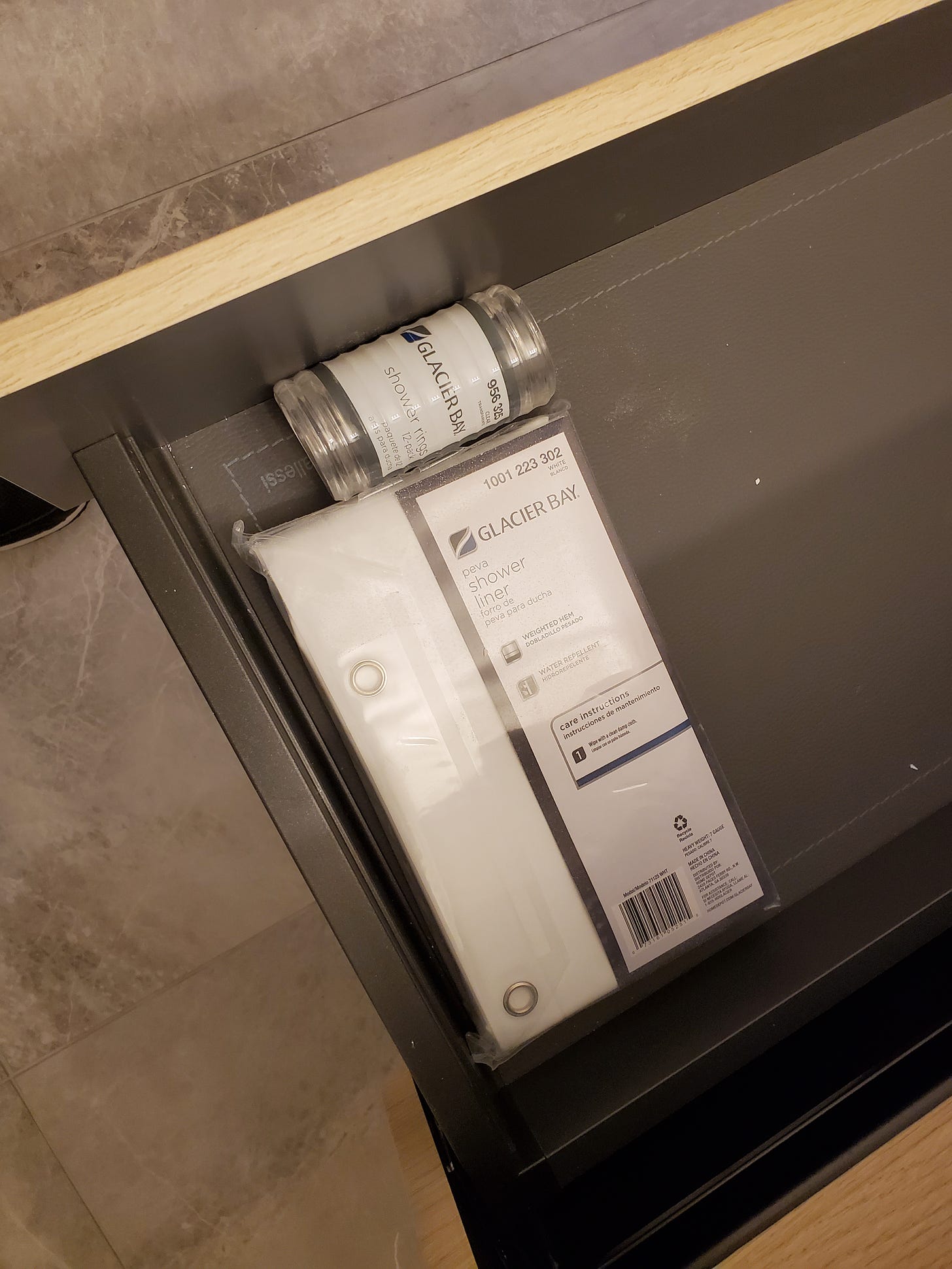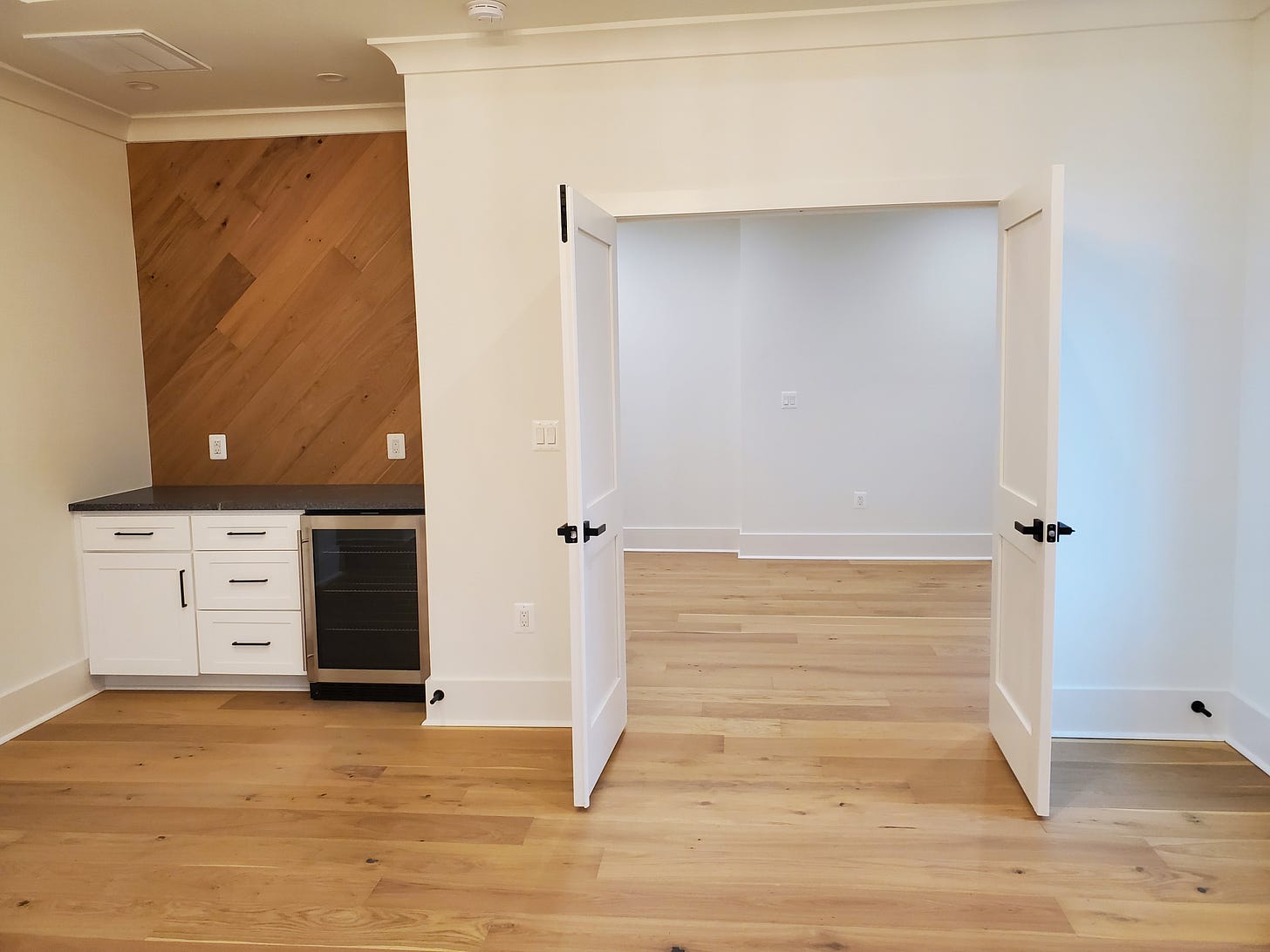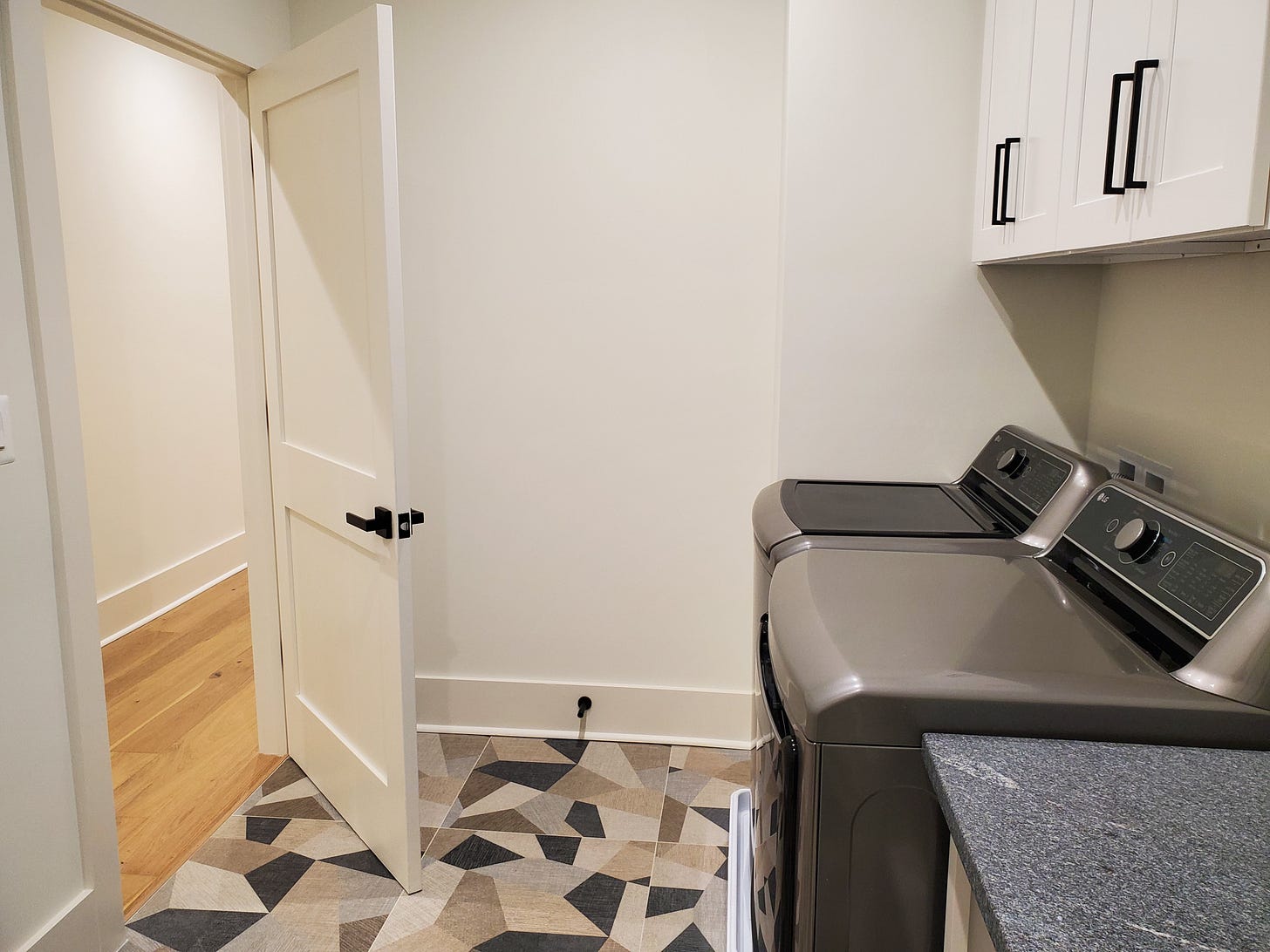The other weekend, my wife and I decided to check out some open houses for very expensive homes in Fairfax County, Virginia. Now, even average, everyday houses are expensive here—almost nothing goes below about $650,000—but the ones we visited were very expensive: starting at about $1.5 million and up to about $2.4 million for one massive new-construction build in Vienna, one of the county’s pricier areas.
I was very curious what that kind of money buys you here, and what a home with that price tag looks and feels like on the inside.
So in that $2.4 million house, this happened:
(Yes, I rounded down on the price. What’s a few hundred grand?)
I wrote about a new-ish townhouse in Lancaster once, pointing out the little flaws in the construction. Like a lot of cheaply built new buildings, it had a flimsy feel to it. That’s the accumulation of using what are called “builder grade” materials, fixtures, and finishes for everything. And of frequently installing them poorly. As to the serious stuff—HVAC, plumbing, electrical, foundation—who knows.
If for some reason you couldn’t watch the video above, here’s a screenshot from it:
The left faucet handle wasn’t anchored properly, and could spin around 360 degrees! Now will that be fixed? Probably. But it’s shocking to me that at this price point, they would show the house with such an obvious and fixable flaw.
I believe that faucet is the Delta Arvo, which retails for about $150 in the “champagne” finish. It’s a nice faucet, but it’s hardly the premium showroom fixture you’d expect in a new house with this price tag.
The faucets were mostly Deltas, while the showerheads were large, square Kohlers—these are nice showerheads, though still available at Home Depot or Lowe’s. (One shower was just a third of the bathroom floor separated by a big plate of glass. There was a smudge on it, where I assume some poor prospective buyer walked into it!)
The toilets, however, were all this model. Glacier Bay is the Home Depot store brand. $2.4 million won’t even get you name-brand toilets. Toilet seats and covers? Plastic, of course.
To complement your designer shower curtain, there’s even a bonus Home Depot store brand shower liner and ring set included!
There’s what appears to be a wet bar in the master bedroom, though it is missing a sink. (I mean, if you want to make coffee you can fill the machine in the bathroom, like in a hotel. But are folks paying over $2 million to make coffee like they’re at the Hampton Inn?)
One home designer on Twitter replied to this photo (which I also tweeted), and said wet bars no longer include sinks. Which makes them dry bars. She said all it’s really for is a late-night La Croix. Do the rich drink overpriced seltzer at night lying in bed? I dunno.
Then there’s the built-in minifridge (harder to repair/remove) and a counter. How well is that fridge made? I can’t tell you, but I do know a lot of these wine-cooler-style fridges use tiny failure-prone computer fans to circulate air. I learned that doing research for this piece. These cheap fans also can begin to run very loud, even if they’re still functional. Any fridge, of course, can run loud. That’s one reason they’re generally not put in bedrooms. Except in hotels and college dorms.
The laundry room is spacious but not wow-worthy. The appliances are ordinary LG models. And it’s upstairs. Some buyers consider that a perk, since the dirty laundry is also usually upstairs. I prefer the laundry machines (and the potentially messy detergent) in a garage-adjacent laundry room, which can also double as a mudroom and place to store tools or chemicals. But that’s a preference.
Thus far…eh. So what, exactly, is the price tag all about? The size: over 6,000 square feet. The bathrooms: eight of them. One for every upstairs bedroom, plus a main-level and basement bathroom. A fully finished basement. And of course, an exclusive neighborhood with tight zoning. The last one is probably the most important. It’s a major reason why houses like this exist in the first place. You can’t build more units to realize the value of the underlying land in these places, so you build more of one unit.
Here’s a Zillow estimated price chart for one of these teardown/rebuild homes in Fairfax County. The massive jump is when the the modest old house was torn down and the new one was first estimated or sold. It’s important to note, again, that this is not price gouging. That value exists, and the zoning determines how it will be manifested. (At least it’s not as bad as the Bay Area, where the barely-inhabitable teardown house itself is listed for almost $3 million!)
Now some people will look at all of this and say, “the ‘housing crisis’ is greed. Why do you want to empower builders when this is what builders crank out?”
But this is what builders crank out when the market allows them to. I don’t want to empower builders per se; I want to fix the market conditions that lead to this house. And I believe the way to do that is to make it easier for more people (not just big developers) to build more, in more places.
But I’m not done: one other major perk of this $2.4 million house is the kitchen, with very high-end, commercial-grade stainless appliances, including a six-burner monster gas range and a built-in fridge. No screens, no touch panels, no gimmicky gadgetry. True premium appliances are very simple, and very sturdy. That kitchen is probably the nicest thing in the house. I believe it’s this Jenn-Air package, which retails for $24,000.
And finally, what else isn’t very nice? The hollow white vinyl railings around the deck!
Seriously—you wiggle these, and they shake. They cannot age gracefully, or be repainted or re-stained. I noticed this throughout our open-house day: the interiors of these $1-2 million houses were magnificent, or at least what passes for magnificent. But the landscaping and outdoor features felt like an afterthought. Is that because people don’t even bother going out?
This house was actually fairly sturdy; it didn’t have that flimsy, hollow feel that a lot of new construction does. Who knows if that sturdiness is an impression or reality. Who knows how long any of it will last, or what invisible corners may have been cut. What is obvious is that these homes are products; a couple of features are chosen to throw money at, to drive sales, and the rest is cheap. That’s why you have restaurant-grade ranges next to Glacier Bay toilets. It’s why you get tinderboxes with marble countertops.
Me—I would, and do, vastly prefer the sort of house my wife and I own. Nothing is spectacular, but everything is good. And a house that’s used—in our case, several decades old—has had plenty of time for any flaws to show themselves and be fixed by previous owners. It’s tested. And a lot of the stuff you see in older houses is very sturdy and well done. (During our house search, I would do things like knock on the walls or shake the doorframes or bannisters, and I found that houses from the ’70s or ’80s had a solidity to them that most of the newer ones lacked.)
There’s a faucet in one of our bathrooms that leaked a little bit, and initially we thought about replacing it. But I found a cartridge and washer kit for it, about $12, and that fixed it. I could tell, opening the faucet up, that it was very heavy and seemingly all metal. It wasn’t a premium fixture; it didn’t even have the brand name etched on it anywhere. I will do anything to keep stuff like that in service, over spending hundreds in parts and installation money for an inferior product that will leak in a year or two anyway.
And when you plunk down $2.4 million, you’re paying for eight of those.
Related Reading:
Still Renting After All These Years
Thank you for reading! Please consider upgrading to a paid subscription to help support this newsletter. You’ll get a weekly subscribers-only post, plus full access to the archive: over 500 posts and growing. And you’ll help ensure more material like this!












I saw a picture once of a high end resort bathroom that had my same $20 Gatco toilet paper roll holder (https://www.homedepot.com/p/Gatco-Form-Toilet-Paper-Holder-in-Chrome-5333/313430132). Now, I'm not one to begrudge someone for refusing to pay an exorbitant price for something whose only job is to hold the roll of paper with which one wipes their butt, and that model is generally serviceable (though I'll note that I consider its design flawed in that it loosens over time and even with the proper allen wrench it's quite difficult to tighten again because it's flush against the wall).
But, burying the lede here, the reason I noticed it in the picture *is because it was installed upside down, with the notch pointing toward the floor* meaning that, in practice, the high-end bathroom did not actually have a functional toilet paper holder.
The gap between what rich people (who do not clean their own homes or do their own research when remodeling, or really do their own cooking a lot of the time) know, and what those of us who do those things ourselves know, has astonished me in my 20ish years of home ownership (we’ve moved several times, sometimes renting and twice buying, both older houses that needed a lot of work). We lived for a year in a one br apartment in downtown DC (my husband opted to spend his entire housing allowance on location rather than space, since it was just a year, and it was fun, if crowded with 3 ppl) that had a backwards kitchen layout and a drawer you couldn’t open bc the handle for the drawer next to it blocked it. Cooking in that apartment was ridiculous. I rented an apartment with a recently remodeled kitchen where the breakfast bar was wide enough that I had to take the cupboard doors off above it to be able to actually access the cupboard (when you opened the doors, they blocked your ability to reach into the cupboard unless you were willing to climb up on the counter that ran perpendicular underneath them). We also rented a house with a gorgeous looking open plan kitchen that meant one was constantly looking at dirty dishes from the living room. But the two houses we’ve owned were both old “handyman specials.” In one we took an 11’x11’ kitchen down to the studs and rebuilt it ourselves for about $5k, using our own labor and my research and design. It became a great working kitchen. Now we’re doing the same sort of thing to a house we bought 14 years ago, having finally gotten to the point where we can afford to remodel: we will spend $$ on good appliances (including a Toto toilet omg those things are impossible to clog and use almost no water) and very little on finishes (ikea butcher block is a way more practical countertop than marble). I’ve definitely learned that what most contractors think ppl want is the latest styles, rather than well-thought out design. It’s weird.